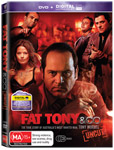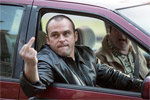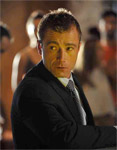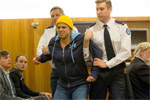Peter Gawler, Paddy Reardon and Helen Magelaki Fat Tony & Co. Uncut DVD Interview
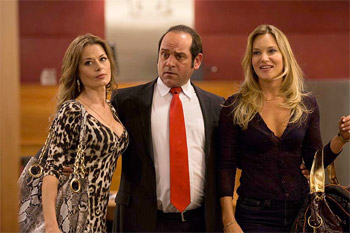
Peter Gawler, Paddy Reardon and Helen Magelaki Fat Tony & Co. Uncut DVD Interview
Interview with Peter Gawler (Producer & Writer)
Question: What was the motivation behind making a series devoted to Tony Mokbel?
Peter Gawler: Principally, because we thought it was a very good story, but it wasn't a story that, for legal reasons, we could tell six years ago when we made series one of Underbelly, as in the middle of pre-production on that series, Tony Mokbel was arrested in Greece. From that point onwards our hands were tied in terms of recounting the full tale of the gangland war and the people involved so we were unable to tell his story. But, in the back of our minds, we always felt that it would be a story that we would like to return to.
And then, through one of the Victorian police officers who had helped us with series one of Underbelly, we met another police officer who, over a coffee, recounted the story of catching Tony. Furthermore, he told me that he had been tracking Tony since 1999. He had been in the Drug Squad where he'd been assigned to investigate Tony Mokbel, then he had moved onto Proceeds of Crime, where he'd also been assigned Tony Mokbel, and then he'd been drafted to Purana 2, where he was again assigned Tony Mokbel. He'd been following Tony Mokbel for eleven years which, in a way, was too good to be true as he had the inside knowledge. Through him, we initially realised what a rich and interesting story it was and that it was not just a story about the Victorian Police, but also a story about the Federal Police, which was a whole new angle.
Question: How do you think that Tony Mokbel is perceived by the general public?
Peter Gawler: I suspect that they regard him as a bit of a lovable rogue because publically he's either in a suit and a red tie pulling faces at the camera or having mug shots taken and wearing a wig the wrong way around.
Question: In a dramatic sense, how is he portrayed in this brand-new series?
Peter Gawler: We portray Tony as a very ambitious and quite capable man, with a good business brain and a determination to get to the top at all costs. A man who is torn however, between his desire to be the biggest player around and a sense of duty to his family and also, genuinely, I think, to the community. He did want to leave a legacy. There are aspects of the Tony Mokbel story that are impossible to reconcile if he was a straight-out gangster whose only ambition was to line his own pockets and destroy everybody in his way.
That amazing building that he was trying to erect on Sydney Road in Brunswick, is, I think, some evidence of that. Also, when he was arrested, he was in the process of purchasing land outside of Athens with the intention of building a medical centre. Now that doesn't sound like Al Capone, or Terry Clark or Carl Williams - there's something else going on. So I think that you have a man who is in fundamental conflict. He loves his mother, he loves his family, he wants to do the best for them, he wants to leave a legacy, he wants to make his father proud, he wants to make his sons proud, I'm convinced of that. So he's a different style of crook.
Question: How important do you think humour is to the show?
Peter Gawler: It's vital. It's real life and they're real people and there's a huge amount of humour in daily Australian life. Traditionally we tend to deal with the worst that life can throw at us with a kind of a deadpan, gallows humour that may or may not have come from the trenches in World War 1 – that's one theory. But whatever it is, it's there - and for all that Tony is a man of Lebanese background born in Kuwait, he grew up in the Northern suburbs of Melbourne, playing Australian Rules Football, with Aussies as close mates. I think that it's just part of him and also where a lot of the humour springs from. A series depends on the character of the central protagonist.
Question: Stylistically does this brand-new series owe anything to the Underbelly franchise or is it completely stand-alone?
Peter Gawler: Consciously, we have made it stylistically different from Underbelly. Although it has several elements in common because it is also true crime drama, but where we can, we've tried to distinguish it from the Underbelly franchise. It has a relatively spare, classic visual style - it doesn't have quite the same kinetic, visual energy that several of the Underbelly shows possessed. Some of those were aligned to a graphic novel style, whereas this isn't.
Question: How has the relationship with Tony Mokbel and Danielle McGuire been depicted?
Peter Gawler: Explosive! It's a great relationship and very credible. You believe that they love each other and you understand why she comes back to him after he's fooled around and why he wants to keep coming back to her even though there have been other women in his life. You understand why she is the partner that he ran away with because she's as tough, feisty and smart as he is – they're a good match.
Question: How do you think the fact that Robert Mammone and Madeleine West have acted together in the past has impacted upon their on-screen chemistry?
Peter Gawler: It's really helped. Their friendship has provided a certain security and comfort level as neither is afraid of looking bad, weak or ugly in the other's eyes, so I think that feeds the on-screen honesty of their relationship. There's genuine warmth and you care about them, which is great. You might deplore what they are - what Tony is - doing, but you nevertheless care about them as people.
Question: Tell us about Robert Mammone's performance as Tony Mokbel.
Peter Gawler: Robert embraced it with two hands, particularly when he knew the full extent of the journey. And being the fine, committed actor that he is, when he met with us in Sydney, he said, 'right, I'm putting on weight now." He liaised with a dietician and worked out when he should be at his heaviest and just committed himself to that course – he didn't really care how he looked – he wanted to be 'Fat Tony" and he wanted to turn himself into 'Fat Tony". He also realised that we were going to have to do major things with his hair, which included cutting a channel down the middle so that he didn't look like a bald man, but more like a monk! It was a huge role for him as he's in the lion's share of the show. He's charismatic, energetic, powerful – all those qualities that you want in a leading man. But he's also playing Mokbel the crook and Robert's not scared to show the ugly or weak sides to Tony Mokbel. If it's on the page, that's what he will do. He can be ugly to Danielle and ugly to women, he can beat somebody with a baseball bat or he can abuse people. If that's the character, that's where he goes. It's an entirely fearless performance - he just puts himself out there and consequently it's an utterly charismatic performance – you can't take your eyes off him. To borrow from Greek culture, he strides across the series like a Colossus.
Question: There are certain characters that appeared in the first series of Underbelly who we meet again in this brand-new series. But this time around, they have a harder edge. Can you explain why?
Peter Gawler: Because the perspective of the storytelling is different, we can look at them in a fresh light. Carl Williams' character was an interesting example of this. For a start, we know more about Carl Williams now than we did when we made series one of Underbelly and can therefore explore, I think, to a greater extent, the man who commissioned so many murders in a way that we couldn't previously. It's our view that Tony's relationship with Carl, which was close – they were mates, I don't think that there's any doubt about that – but we now realise that Carl did present a real danger to Tony - that Tony was too close to this highly volatile, dangerous felon, so we needed to dramatise that to show Tony's dilemma in a clearer light. So that's one of the reasons. Also, the Morans are seen again, but from a different perspective and it was important to us to depict them as violent, hostile crooks, which contrasts with Tony's style, so that was something that we did consciously.
Question: I believe that part of the series was filmed in Greece. Can you tell us about that experience?
Peter Gawler: Filming in Greece was tricky but we needed to do it and the only time that we could do it, in terms of our post-production schedule, was before we started main unit shooting as we had access to the actors and the director, so we simply couldn't wait to do it after the shoot. But the problem we faced was that the scripts for the later episodes were still being developed, so to some extent we were -whistling in the dark'. You might write a scene that you think you may need in half a dozen episodes time but you can't be sure as things change. So there were continuity issues, just in terms of what we were going to shoot, and how we were going to shoot it. Also, Athens is a tricky city in which to film, as, just like everywhere else, you need to seek permission for everything. Being overseas doesn't make it any easier and as a foreign unit you can't just come in and lay waste to Athens. So we operated through a Greek production company and they were fabulous. We had a terrific crew and got a lot shot. And we took three actors over there – Robert, of course, along with Stephen Curry and Richard Cawthorne who played the two police officers sent to Greece by their respective police agencies to find Tony and bring him home. We shot there for around eight or nine days and then when the actors returned to Australia, we spent a couple of days placing cameras in cars and just driving around and doing some pretty interesting stuff like following prison vans. I think that if the authorities had realised what was happening, our director and camera crew could have found themselves in the back of a prison van themselves! But it was totally invaluable and the whole experience of filming in Greece has just opened the series out.
Question: Do you think that Fat Tony & Co., carries any particular message?
Peter Gawler: The point that we're trying to make is that in times of adversity, Australians will naturally form a team. In this particular story we have the Victorian Police and the Federal Police who don't always see eye-to-eye – there are frictions between all law enforcement agencies – but because the pursuit of Tony Mokbel was an international job, the Federal police and the Victorian Police joined forces and they did so effectively, solving the problem and getting their man. That's a triumph that I feel that this series recognises.
And the other point that we make concerns a police saying. It's said that, 'organised crime can exist without systemic corruption but it can't grow," and organised crime grew through the nineties and the early years of 2000. I suspect that was because there was a level of corruption, which is what Tony Mokbel was feeding on.
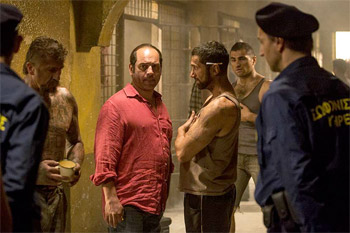 Interview with Paddy Reardon (Production Designer)
Interview with Paddy Reardon (Production Designer)
Question: What sort of colour palette did you adopt?
Paddy Reardon: It's quite a complicated tale so it was important to delineate the various camps in the storyline. On one side you have the Purana Task Force, and on the other, the various criminal elements associated with Mokbel. So at an early stage we divided the spectrum so that we could use the blues and greens for the lawmakers and the reds to mauves for the criminals. That was further broken down when Tony goes to Greece, for which we adopted a group of colours that utilised white clay shades and earth tones for several scenes that were set there. Simultaneously, we incorporated light blue shades to match some of the colours we had encountered in Athens. So although it was quite a complicated colour palette, we tried hard to give the audience a clue as to where they were at any time, because there were many scenes that were intercut with up to five locations. So that became one of the motivating factors for the production design.
Paddy Reardon: We were definitely after a Mediterranean feel. Some of the elements that we had gleaned from reference photos and locations indicated quite a Rococo complexity to some of the furnishings – he wasn't adverse to a bit of luxury. So where possible we used gold and red plus oil colours, along with lots of patterned fabrics and black, which gave the impression of a heavy, brocade sort of life. We also incorporated quite a bit of black with his cars, as that was another of his signature colours.
Question: What was the biggest challenge in finding and dressing Melbourne locations to replicate Greece?
Paddy Reardon: Trying to replicate another country is always challenging. One of the ways in which we achieved that was to try and find architecture that we hadn't previously used in Melbourne for any key locations. We did manage to find some brutalist architecture, constructed from concrete and stone, which was a good match for our Greek police station because it's easy to find stonework in Greece. So we took that as a theme and, as far as we could, tried to match the nature of the Greek buildings. To some degree it also worked with Mokbel's Greek apartment, which was older in style, with railings and quite distinctive detailing – so we copied that look for the Melbourne apartment that was used as his Greek abode. Sometimes it was viable to just find a distinctive apartment, as if it looked sufficiently outlandish it could be perceived as being in Athens - so that's initially what we went hunting for.
Question: Stylistically, what were the main differences between the Melbourne police station and the Greek police station?
Paddy Reardon: The Melbourne police station was shot in a city block that looked down Flinders Lane and we painted the interior with dark, ultra marine blue and black as signature colours. We also decided to incorporate the outside world, so we shot several scenes in front of a picture window that looked south. Wherever possible, we tried to involve the outside world in the Purana landscape.
We shot the exterior of the Greek police station, which was white marble with a concrete structure, in Athens. To match the exterior when filming the interior scenes when back in Melbourne, we found a fairly brutal looking stone and concrete building which I skinned with a black basalt look. This gave it a stone heavy, almost military feel. It also featured fewer windows than the Melbourne police station.
Question: Tell us about the sets you designed to double for Korydallos Prison.
Paddy Reardon: Korydallos in Athens is regarded as one of the most hard-edged, maximumsecurity prisons in Europe. I was lucky to find one piece of footage online that was shot by an inmate. Even though the quality is quite poor, you can clearly see the nature of the place. But whenever people talk about Greek prisons they start thinking about Midnight Express, which was actually a Turkish prison. I looked at that, and could see what the art department had been aiming for, but felt that as that was filmed in 1978 and because we were shooting a different kind of show, we could probably do something a little better.
For me, the moment when Tony walks into the prison, after having earlier said, 'I'll do this time in the Greek prison easy," was the key – we wanted him to enter and be shocked. So we filmed outside of Korydallos Prison - and it does looks reasonably hard edged - but I made the interior look a lot harder than the exterior so that it's almost like a descent into hell. We built the prison in a very rustic, almost cave-like way, with lots of aging and a colour palette that ranged from ochre through to sand. We also aged it heavily. The photos I've seen depicting the living areas of the real Korydallos Prison are actually quite white and stark, but I decided to lower the tone, so also added wet walls and backlighting to make it look quite cavernous and almost medieval. We also had great casting of extras, so were able to create a kind of hellhole for Tony's introduction to the Greek prison system. So you could say that we did veer a little bit from reality.
Question: Tell us about the set for Tony's nightclub.
Paddy Reardon: In real life, Tony's nightclub was a Melbourne eatery that was on the street, which you could see into. On the surface, it was quite upmarket and visually arresting. We took that a little further underground and turned it into a darker, more multi layered and coloured experience because it transpired that in telling the story throughout the first few episodes, we needed to inject a little more colour into some of the locations. So we chose Tony's eatery and heightened it with plenty of neon along with a European pattern and colour scheme to match Tony's more Mediterranean outlook on life.
Question: Tell us about the set for the scene in Episode 7 where the Greek police officers take their Australian counterparts out for dinner.
Paddy Reardon: We'd already shot the exterior of these locations in the tourist district of Athens, which is located near the railway station. When I reviewed the location photos of this area, which were sent to us by the Greek production company, I said, almost jokingly to our director, that I was reminded of the Dog's Bar in St Kilda, which is a very iconic venue. When it came time to film the interior scenes we did actually investigate a few Carlton locations, but I felt that with the sequences towards the end of the show, we could actually get a little closer with our match, so we negotiated to use the Dog's Bar for a few hours. It was the right colour and had the right architecture already, so we were halfway there. We just changed the menu boards to Greek and added a little more of the Greek decoration that is typical of those tourist restaurants in Athens.
Question: Is it difficult to replicate a drug lab?
Paddy Reardon: We recreated nine drug labs throughout the series and decided to make each of them different – a decision that we arrived at by virtue of reference. It's easy to make them all look the same, but challenging to make them look diverse. So I felt that for the sake of the story and the various characters that appear in each drug lab, we owed them the debt of looking different from one another. We therefore used a few devices – i.e., we shrouded them all in different coloured plastics that shielded them from the outside world, so that we were working with red or blue or yellow or green – a quite simple sort of badging. But generally speaking, the process of making speed or ecstasy- or any other drug for that matter - is relatively easy to identify. Anybody, like myself, who has completed VCE Chemistry, is pretty much across the technicalities of it so the business of designing a drug lab wasn't hard. The dressers did have a bit of trouble sourcing some of the equipment because really the only reason you would use various items would be to build a drug lab, but once we were over that issue and people realised that we were making a film, we were able to get on with it and badge each lab differently – mainly through the colour and lighting.
Question: Tell us about the yacht that transports Tony from Australia to Greece.
Paddy Reardon: This was an interesting challenge as first of all he buys a luxury yacht, then transports it from Newcastle to Fremantle where it's refitted for his purpose and then stows away on it and sails it to Greece.
All of the various ports that they visit along the way were shot in Melbourne at a number of different marinas. There was also no actual match for the yacht that was bought – and is still sitting in Athens - and we couldn't use that! Plus there were a number of sequences which were filmed at sea that needed to replicate the Indian Ocean, the Gulf of Aden, the Suez Canal and so on. Most of those were shot in Port Phillip Bay amidst various weather conditions, some of which left half the crew seasick. There was also a sequence where Customs board the yacht and Tony hides in what was basically a locked cupboard beneath another cupboard, whilst Customs search the boat. We built that cubbyhole in our studio. So at some points there were about five or six elements to the yacht. We also used quite a bit of CGI because in the real story the yacht was placed on a trailer and transported across the desert, but that wasn't going to be possible for us, so, with some effort, it became a CGI element.
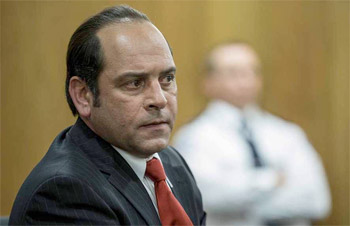 Interview with Helen Magelaki (Hair & Make-up Supervisor)
Interview with Helen Magelaki (Hair & Make-up Supervisor)
Question: How did you approach designing Robert Mammone's hair for his role as Tony Mokbel?
Helen Magelaki: It was tricky because Robert has a very thick, full head of hair and Tony Mokbel, of course, had receding hair. I knew the approach I was going to take, but my biggest challenge was that we weren't in a position to shave Robert's hair before he went to Greece, so we only had about ten days to get it right before we started shooting.
I commissioned a wigmaker to craft Robert's hairpiece. We spoke about what I wanted, and as our wigmaker was based in Sydney, we accumulated a lot of correspondence! The wigs are all hand-manufactured – people don't realise how much skill and time is required to make one. These days it's a craft that's not practised by many people, as it's extremely time consuming and taxing on your eyesight. A wigmaker can sit for twelve hours, knotting for approximately two weeks to make a wig.
Once the wig was finished and Robert returned from Greece, the wigmaker came to Melbourne and we did a fitting with Robert. The process probably took around six hours with Robert sitting in a chair over a two-day period, as we had to partially shave his head (top of his scalp) in order to get his hair as close as possible to Tony Mokbel's. Shaving Robert's hair was a daily procedure. But at the beginning, in preproduction, it was a slow process as if we removed too much it left a big hole underneath where the wig sat. So one person would be shaving and the other would be holding the wig so that we knew exactly where to remove Robert's hair. Then we would dry-trim the remaining hair around the sides of his scalp, which would be stretched and blow-waved straight as Robert's hair, although not curly, has a lot of movement. The section of his hair that we didn't remove was from the crown and just above his ears coming around to the temple at the sides of his head. So every day we needed to clean shave the top of his scalp but this would leave a very white area as with Robert having such thick, dark hair, his scalp never sees any sun. To overcome this we had to blend six or seven different shades of special film industry make-up to disguise the white area where the skin on the top of his head met his forehead. Once that process was completed, we would glue the wig on and then apply more layers of make-up to the top of the wig's lace. It would take two people approximately an hour and a half every morning. Once that wig came off, it needed to be cleaned and prepped for the next day's filming, which was also a big process.
We had two wigs that we would alternate. They were fashioned from real hair and were very finely knotted, so we had to be extremely careful, as they were terribly fragile and also needed to last us for fourteen weeks. You really have to know how to look after such delicate hairpieces. Every night we had to put pins in the lace so that they would retain their shape as it's basically like when you wear a new pair of jeans and the fabric stretches, but when you wash it, the fabric shrinks and they feel snug again. It's exactly the same with a wig. Every night we'd have to wet it so that when the lace supporting the hair had dried, it would shrink back to its original shape.
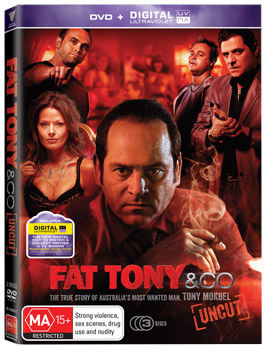 Fat Tony & Co. Uncut DVD
Fat Tony & Co. Uncut DVD
Cast: Robert Mammone, Hollie Andrew, Steve Bastoni, Nicholas Bishop, Craig Blumeris, John Brumpton, Tawni Bryant, Debra Byrne, Dean Cartmel, Richard Cawthorne, Vince Colosimo, Zoe Cramond, Matthew Crosby, Stephen Curry, Lester Ellis, Nick Farnell, Rowan Francis, Gyton Grantley, Kevin Harrington, Les Hill, Shane Jacobson, Odette Joannidis, Gerard Kennedy, Christine Keogh, Simone Kessell, Jeremy Kewley, Antonio Lancuba, Louise Mandylor, Maria Mercedes, Louisa Mignone, Dan Mor, Tony Nikolakopoulos, Ben Noble, Ryan O'Kane, Vince Poletto, Robert Rabiah, Jake Ryan, Frank Sweet, Samantha Tolj, Alex Tsitsopoulos, Kym Valentine, Brian Vriends, Madeleine West, Simon Westaway, Tom Wren
Directors: Peter Andrikidis, Andrew Prowse, Karl Zwicky
Genre: Crime, Drama
Rated: MA
Running Time: 385 minutes
Fat Tony & Co., the brand-new production from Screentime, tells the story of Australia's most successful drug baron, from the day he quit cooking pizza in favour of cooking drugs, to the heyday of his $140 million dollar drug empire, all the way through to his arrest in an Athens café and his whopping 22-year sentence in Victoria's maximum security prison.
Already a key player on the Australian drug scene in his own right, Fat Tony becomes more deeply embroiled in the underworld as he joins forces with up-andcoming drug dealer Carl Williams. He strikes an uneasy truce with the Carlton Crew, the territorial and dangerous royalty of the Melbourne underworld, even doing business from time to time with the Moran family. With his three brothers and Carl Williams, Tony expands his drug empire into a multi-million dollar industry, all the while investing his profits in honest bricks and mortar, determined to leave a legacy for the family and the city that he loves.
However, the burning tension between Carl and the Carlton Crew is quickly devolving into all-out war – the Melbourne Gangland War that would eventually claim some thirty lives. Tony is losing control of his well-ordered operation, and is finding it harder and harder to remain a neutral businessman. But Tony isn't like other underworld figures - he always has a plan and an eye to the future, even when it seems like the police have closed every door to him.
The ambition and drive that it took for Tony Mokbel to rise from a suburban milkbar owner to Australia's most wanted man was matched only by the sheer determination of the police in their ten-year battle to shut Fat Tony down. The Victorian and Federal police undertook a marathon attempt to bring him to justice, spanning countless arrests, legal battles and the downfall of more than one corrupt officer.
Fat Tony & Co. is the true story of Tony Mokbel; how he grew entangled with the country's most notorious underworld figures, how he built his massive fortune, and how he became a fugitive on a yacht bound for Greece, desperate to escape mounting criminal law battles.
Fat Tony & Co.
RRP: $49.95
Have You Seen This?
MORE


